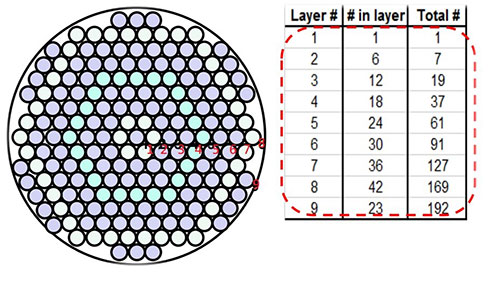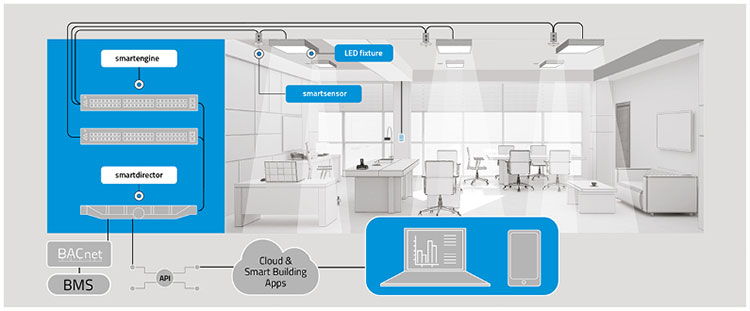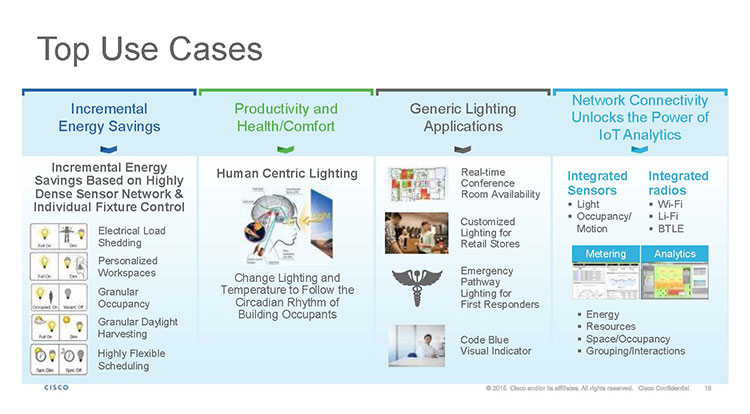With Power over Ethernet (PoE) cabling, you can reduce or eliminate the need for power supplies for wireless access points, IP security cameras, digital signage, videoconferencing equipment, or other IoT devices that are far away from a power socket. PoE transmits voice, data, and power over a single twisted-pair cable. For safe operation, consider temperature, voltage, and cable length when installing Power over Ethernet (PoE) cable. Several established standards define PoE cable requirements. National Electric Code® (NEC®) and Underwriters’ Laboratories® (UL®) standards address safety requirements.
Power over Ethernet (PoE) combines voice, data, and power delivery over just one twisted-pair (TP) cable. Current standards include PoE Type 1, PoE+ Type 2, PoE++ Types 3 and 4, PoH, UPoE, and UPoE+, as described in Table 1.
PoE and PoE+ are older standards that support 15.4 W and 30 W, respectively. PoE++ Type 3 supports 60 W.
The latest PoE++ standard is IEEE 802.3bt (Type 4). This standard supports 100 Watts maximum power over a TP cable that can be up to 100 meters (or 328 feet) long.
The Power over HDBaseT (PoH) standard, based on the original PoE standard (IEEE 802.3at), enables sending 100 watts over a four-pair Ethernet cable.
Cisco® Universal Power Over Ethernet (UPoE) and Power over Ethernet Plus (UPoE+) standards extend the IEEE Power over Ethernet standard, use LLDP (Link Layer Discovery Protocol), and put spare pair PoE information in to TLV frames for power negotiation by 4- pair wires, which is different than how PoE+ works.
Table 1. PoE Standards
| Type | Standard | Power to Powered Device (PD) | Max. Power per Port | Energized Pairs | Nominal Max. DC per Pair | Supported Devices |
|---|---|---|---|---|---|---|
| PoE | IEEE 802.3af (Type-1) | 12.95 W | 15.4 W | 2-pair | 0.35 A | Static or PTZ cameras, VoIP phones, wireless access points |
| PoE+ | IEEE 802.3at (Type-2) | 25.5 W | 30 W | 2-pair | 0.6 A | PTZ cameras, video IP phones, alarm systems |
| PoE++ | IEEE 802.3bt (Type 3) | 51 W | 60 W | 4-pair | 0.6 A | Video conferencing equipment, multi-radio wireless access points |
| PoE++ | IEEE 802.3bt (Type 4) | 71.3 W | 100 W | 4-pair | 0.96 A | PoE-Powered LED Lighting, outdoor PTZ cameras |
| PoH (Power over HDBaseT) | HDBaseT | 72– 95 W | 100 W | 4-pair | 0.95 A | HDBaseT AV devices |
| UPoE | Cisco | 51 W | 60 W | 4-pair | 0.6 A | Cisco and compatible devices |
| UPoE+ | Cisco | 71.3 W | 90 W | 4-pair | 0.96 A | Cisco and compatible devices |
The key difference between PoE and PoH is that a PoH device PD will identify the cable length and draw more power as long as it does not exceed the 100W limitation. PoH allows multiple PD devices to be daisy- chained and all powered through higher-power extenders.
PoH has the same concerns as PoE as it carries higher DC power over Ethernet cable. H eat rise in bundled cables impacts the insertion loss. Ensure that the cable temperatures do not exceed the TIA standard defined maximum operating temperature of 60°C. At higher temperatures, the insulation material resilience and data transmission quality decrease. Consider o ther factors such as power loss and heat dissipation as well.
Table 2. PoE Related Standards
| Organization | Standards |
|---|---|
| National Fire Protection Association (NFPA) | NFPA 70, National Electrical Code 2020 |
| Telecommunications Industry Association (TIA) | TSB-184-A: Guidelines for Supporting Power Delivery Over Balanced Twisted-Pair Cabling |
| UL | Limited-Power (LP) Cable Certification |
| ISO/IEC | IEC 60512-99-001 Connectors for electronic equipment - Tests and measurements - Part 99-001: Test schedule for engaging and separating connectors under electrical load - Test 99a: Connectors used in twisted pair communication cabling with remote power |
| ISO/IEC | IEC 60512-99-002 Connectors for electrical and electronic equipment - Tests and measurements - Part 99-002: Endurance test schedules - Test 99b: Test schedule for unmuting under electrical load |
| IEEE | 802.3af |
| IEEE | 802.3at |
| IEEE | 802.3bt |
Now that you are familiar with the types of PoE and related standards, let’s address some safety standards governed by the National Electric Code (NEC) and Underwriters’ Laboratories (UL).
The National Electrical Code (NEC) defined temperature limits on electrical conductors as a fundamental safety requirement.
In 2020 NEC article 725.144, an ampacity table shows 4-pair, 22, 23, 24, and 26 AWG cables rated for 60, 75, and 90 degrees Celsius, and bundle size from 1 to 192 cables.
Table 3 describes ampacity as the maximum current that a conductor can carry continuously under the conditions of use without exceeding its temperature rating.

The NEC Table 725.144 above displays an ambient temperature of 30°C (86°F) with all conductors in all cables carrying current, 60°C (140°F), 75°C (167°F), and 90°C (194°F) rated cables.
Note: Where only half of the conductors in each cable are carrying current, the values in the table 725.144 can increase by a factor of 1.4.

Article 725.144 provides three compliance options for installing a typical 4-pair LAN cable with 22, 23, 24, or 26 AWG conductors.
Limited Power (LP) testing is not mandatory by the National Electrical Code (NEC), but when you see the LP with a specific ampere rating on a cable legend, this LP cable designation indicates that the cable has been evaluated to carry the marked current under reasonable worst-case installation scenarios without exceeding the temperature rating of the cable.
In section 725.154(I) 2020, NEC addresses LP (Limited Power) cable. NEC lists LP cable as suitable for carrying power and data up to a specified current limit for each conductor without exceeding the temperature rating of the cable where the cable is installed in cable bundles in free air or installed within a raceway, cable tray, or cable routing assembly. The cables shall be marked with suffix “LP(XXA)” where XXA designates the current limit in amperes per conductor.
Here is an example of an LP LAN cable legend below.
BLACK BOX CORPORATION GUARANTEED FOR LIFE ( 724) 746-5500 ---CATEGORY 6 SHIELDED ---E196163-P C(UL)US CMP-LP (0.6A) F/UTP 90°C 4PR 24AWG 3P VERIFIED ANSI/TIA-568-C.2 CAT 6 TESTED TO 400MHZ MM-YY XXXXFT
“CMP-LP (0.6A) F/UTP 90°C 4PR 24AWG” means that this cable is a 4-pair plenum cable with 24 AWG conductors, a temperature rating of 90°C, and a current limit of 0.6 amperes per conductor. The LP cable clearly determines the cable bearable amperes and the ampere rating is marked on the cable jacket. When the power- supplying device requires higher than 60W and the cable bundle size is unknown, you definitely need an LP certified cable.
Applications for PoE cable that complies with established standards and safety requirements include lighting for smart buildings.
NAP2020, ARTICLE 411: Lighting Systems requires lighting equipment to operate at no more than 30 Volts AC or 60 volts DC using wiring supplied by Class-2 Power Sources. This standard covers structured cabling used for low-voltage lighting (it generally requires that wiring must meet Article 725 requirements for power limited wiring).
Easy and cost-effective PoE LED lighting technology is often used in smart buildings, since it reduces the installation cost and space by using just one LAN cable. A luminaire has its own IP address, so you can manage it as an Internet of Things (IoT) device.


Here in Part 1 of this blog, we discussed PoE cabling types, standards, and safety. For information about testing PoE cable and connectors for compliance and safety, as well as choosing your PoE cable, please read Part 2 of this blog. Black Box offers a wide range of standards-compliant PoE cable to fit your application.

Product Engineer
George Liu has 12 years’ experience in the cabling, data, and video connectivity industry. As a Project and Product Manager at Black Box, he works directly with domestic and international OEM suppliers on new product launches. George is a certified PMP and CQE, and he is a master’s candidate in the industrial management program at National Taiwan University of Science and Technology.